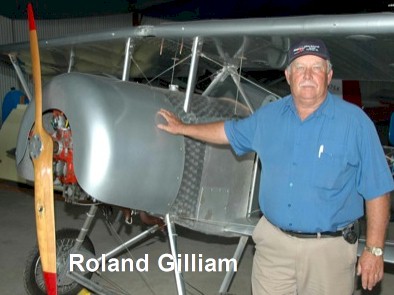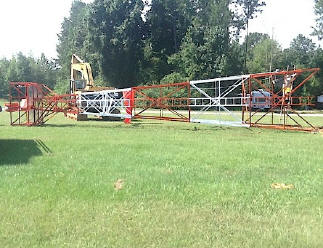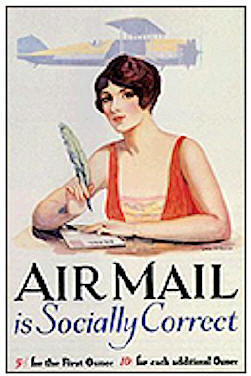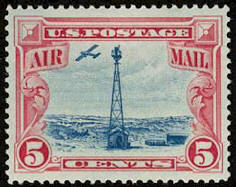


About Us
Exhibits
Photos
Membership
Business
Sponsors
Donations
Gift Shop
Contact
Links
~ ~ ~
James R.
McConnell
Page
Robert H.
Upchurch Page
~ ~ ~
Memorial
Brick
Campaign
~ ~ ~
GENERAL
AVIATION NEWS
November 6, 2013
Original Airway Tower erected
at Gilliam-McConnell, Carthage
While visiting a customer at the Norton Municipal Airport (KNRN) in Kansas in March 2012, I learned that the airport’s owner needed to dispose of their old beacon tower. Suspecting that it had historic value, I suggested they offer it for sale.
I had my friend Roland Gilliam in mind, owner of the Gilliam-McConnell airport (5NC3) in Carthage, N.C. As reported by Bill Walker in the March 11, 2010, issue of General Aviation News, Gilliam is transforming his airstrip in the Sandhills region of central North Carolina into one of the most popular pilot destinations in the area.
In addition to a good runway with easy approaches, hangars, home sites, RV hookups, a driving range, full-scale P-40 replica, two memorials to World War I and World War II fighter pilots and the famous Pik-n-Pig BBQ restaurant, Gilliam has been quietly building a collection of aircraft and aviation memorabilia for a new museum on the field. The largest object in that collection is the Norton tower, which Gilliam acquired and hauled back to North Carolina last year.
He explains below how this all happened and the special significance of the tower and its location:
“Last summer Kent Misegades sent me some pictures of the tower at the Norton airport where he furnished a new fuel station. I was interested, but wanted to know if it was an authentic airway beacon tower. I sent pictures to LaFarr Stewart in Arizona and Tom Johnson in California, experts on these towers, who both said it looked like an original, but added they needed more details to be sure.
I called Norton County and made an offer that was quickly accepted.

I always wanted an airway tower at my airport, as I have a 1920′s post office from our town of Carthage displayed in the Pik-n-Pig Restaurant on the field. The Norton tower is also from the 1920s. It has “Carnegie Steel” embossed on its girders. However, we found that the tower was not originally in Norton but moved there from somewhere else. We are still trying to determine where. Maybe someone reading this can help us?
The tower will be part of the James Rogers McConnell Air Museum — named after the World War I ace from Carthage — to be built a short distance away. We are trying to get funding now to construct the building.
I already have three World War I planes and one more plane to go into the museum. We also have monuments to World War I and World War II pilots who lost their lives in these wars.


One of my employees and I drove out to Norton last November. I hired a crane to lower the tower after we had cut it loose from its pad. The first thing I looked at was the electrical power panel. It had a fuse labeled for the beacon and a fuse for each of the two course lights. This told me it was an authentic airway tower. I laid the tower in one piece onto a borrowed wedge car hauler; it looked like it was made for that 51 foot tower! I pulled it with my Freightliner hauler. The total trip out and back was 2,980 miles. The tower arrived at its new home in perfect condition with no rust whatsoever — galvanizing back in the 1920s was excellent.
The tower came without a beacon, but I was able to locate an original one from Tower Number 31, erected 310 miles from Atlanta on the New York to Atlanta mail route. My brother Wilson and I retrieved it last Thanksgiving, along with a hive of honeybees that had filled it completely with honey. Dr. Allison Page and his family donated the beacon to our museum. He owns a small airport in Yanceyville, N.C., where the Number 31 tower supports the local fire department’s WWII siren.
To restore our new tower, all I had to do was a little scraping before repainting it with authentic orange and white paint from a company in Missouri. We set it onto concrete footings poured on Aug. 30, raising it to its permanent location on Sept. 5.
The tower is dead-center under the Victor 66 airway, which coincidentally also crosses over my house two miles away, and over my father’s house in rural Franklin County, N.C., 104 miles from my airport.
As funds permit, my next plan is to pour the 70 foot long concrete arrow pointing to the Raleigh-Durham Airport (KRDU), also under Victor 66.
I am looking for a parabolic mirror and glass lens for the 24 inch airway beacon. Unfortunately, vandals broke them, along with the two 1,000 watt bulbs, before we picked up the beacon from Yanceyville.
I plan to keep adding historic items as I find them. The museum will accept most anything of value to display, or to resell and help offset costs. We are selling engraved bricks for $150 for the base of the monument to Carthage native son, World War I ace James McConnell. Residential and hangar lots are also available on the airport property. I am 73, still pursuing my dream, and will continue as long as I can.”




We Gratefully Thank and Acknowledge Our Generous Sponsors
Copyright James R.
McConnell Air Museum Inc. - 2014 - All Rights Reserved
Web Design by Plank Road Consulting -
www.plankroadconsulting.com





